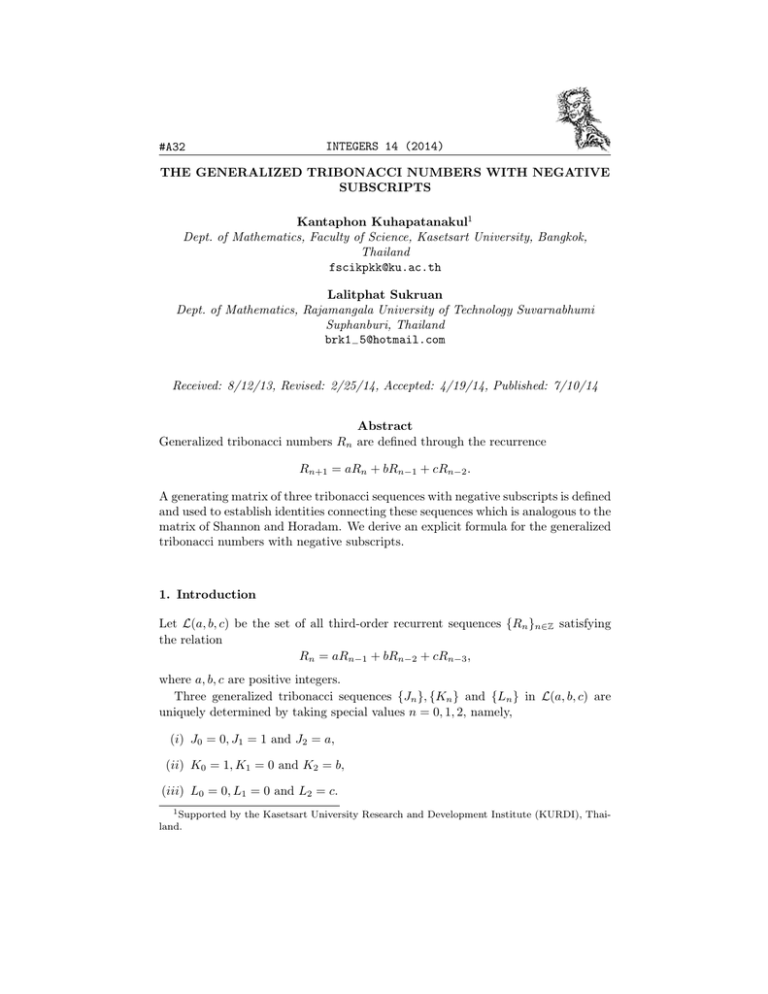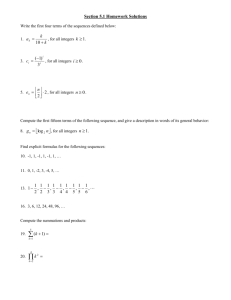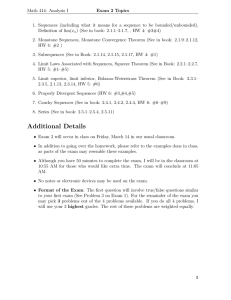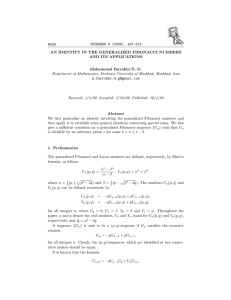INTEGERS 14 (2014) #A32 THE GENERALIZED TRIBONACCI NUMBERS WITH NEGATIVE SUBSCRIPTS
advertisement

#A32
INTEGERS 14 (2014)
THE GENERALIZED TRIBONACCI NUMBERS WITH NEGATIVE
SUBSCRIPTS
Kantaphon Kuhapatanakul1
Dept. of Mathematics, Faculty of Science, Kasetsart University, Bangkok,
Thailand
fscikpkk@ku.ac.th
Lalitphat Sukruan
Dept. of Mathematics, Rajamangala University of Technology Suvarnabhumi
Suphanburi, Thailand
brk1 5@hotmail.com
Received: 8/12/13, Revised: 2/25/14, Accepted: 4/19/14, Published: 7/10/14
Abstract
Generalized tribonacci numbers Rn are defined through the recurrence
Rn+1 = aRn + bRn
1
+ cRn
2.
A generating matrix of three tribonacci sequences with negative subscripts is defined
and used to establish identities connecting these sequences which is analogous to the
matrix of Shannon and Horadam. We derive an explicit formula for the generalized
tribonacci numbers with negative subscripts.
1. Introduction
Let L(a, b, c) be the set of all third-order recurrent sequences {Rn }n2Z satisfying
the relation
Rn = aRn 1 + bRn 2 + cRn 3 ,
where a, b, c are positive integers.
Three generalized tribonacci sequences {Jn }, {Kn } and {Ln } in L(a, b, c) are
uniquely determined by taking special values n = 0, 1, 2, namely,
(i) J0 = 0, J1 = 1 and J2 = a,
(ii) K0 = 1, K1 = 0 and K2 = b,
(iii) L0 = 0, L1 = 0 and L2 = c.
1 Supported by the Kasetsart University Research and Development Institute (KURDI), Thailand.
2
INTEGERS: 14 (2014)
These sequences have been studied by many researchers (for more details see [5][7]). If a = b = c = 1, then {Jn } is a sequence of the classical tribonacci numbers,
say {Tn }. It can be written Rn as a linear combination of Jn , Kn and Ln , namely,
Rn+1 = R2 Jn + R1 Kn + R0 Ln ,
and the following relations are easily proved, see [4], [5] or [7],
Jn+1 = aJn + Kn , Kn+1 = bJn + cJn
1,
and Ln+1 = cJn .
(1)
In 1972, Shannon and Horadam [7] constructed the 3 ⇥ 3 matrix and computed
the nth power of this matrix
2
3n 2
3
a b c
Jn+2 Kn+2 Ln+2
41 0 05 = 4Jn+1 Kn+1 Ln+1 5
0 1 0
Jn
Kn
Ln
and they showed that
(a + b + c
1)
n
X
Ji = Jn+3 + (1
a)Jn+2 + (1
a
b)Jn+1
1,
i=1
Jn+1 =
[n/2] [n/3] ✓
X X
i=0 j=0
i+j
j
◆✓
n
◆
i 2j n
a
i+j
2i 3j i j
bc ;
see also [1], [2], [5], [6].
The sequences {Jn }, {Kn } and {Ln } can be defined for negative values of n by
using the definition of any recurrent relation and initial conditions. The first few
terms of them are shown in the following table.
n
1
2
3
4
(b2
Jn
0
1/c
b/c2
ac)/c3
Kn
0
a/c
(ab + c)/c2
2
(a c ab2 bc)/c3
Ln
1
b/c
(b2 ac)/c2
2
(c + 2abc b3 )/c3
In this article we construct certain matrices for J n , K n , L n and partial sums
of J n to derive interesting identities involving these numbers. We also derive an
expansion of J n in a partial sum of binomial coefficients.
2. Matrix Representations
For n 2 N, define the 3 ⇥ 3 matrices A and Cn as follows
2
3
2
b/c
a/c 1/c
L n 1
0
05
A=4 1
and
Cn = 4 L n
0
1
0
L n+1
K n 1
K n
K n+1
3
J n 1
J n 5.
J n+1
3
INTEGERS: 14 (2014)
Theorem 1. For all n 2 N, we have An = Cn .
Proof. (Induction on n) Using the above table (section 1), one can see that A1 = C1 .
Assume An = Cn holds for n > 1. By our assumption and a matrix multiplication,
we get An+1 = An A = Cn A, which, by using all equations in (1), satisfies An+1 =
Cn A = Cn+1 . Thus, complete the proof.
Since An+m = An Am , equating the (2, 1), (2, 2) and (2, 3)-entries on both sides
of this matrix equation, we get the following corollary.
Corollary 1. For m, n 2 N, we get the relation
R
m n
=L
mR n 1
+K
mR n
+J
m R n+1 ,
+R
1J m,
+R
n+1 ),
where Rn is Jn , Kn or Ln .
Taking n = 2 and m = 2 in Corollary 1, we get
R
R
m 2
n 2
=R
=
3L m
1
( bR
c
+R
n 1
2K m
aR
n
respectively.
Next, for n 2 N, we define the 4 ⇥ 4 matrices B and Dn as follows
2
3
2
3
1 0 0 0
1
0 0 0
61/c
7
6S n 1
7
7
7,
B=6
and
Dn = 6
4 0
5
4
5
A
S n
Cn
0
S n+1
Pn
where S n = i=1 J i and S0 = 0.
Theorem 2. For all n 2 N, we have B n = Dn .
Proof. Since L n+1 = cJ n , we can write S n 1 = S n + 1c L n . Combining the
above identity and the result of Theorem 1, we write Dn = Dn 1 B. By using
induction on n, the result still holds.
Corollary 2. For all positive integers m, n, we have
S
m n 1
=S
m 1
+L
m 1S n 1
+K
m 1S n
+J
m 1 S n+1 .
(2)
Proof. Since Dm+n = Dm Dn , we have the equation (2) by equating the (2, 1)-entry
on both sides of this matrix equation.
Now we derive an explicit formula for partial sums of J
theorem.
n.
We have the following
4
INTEGERS: 14 (2014)
Theorem 3. For n
n
X
J
i
1, we have
1
a+b+c
=
i=1
1
(1
cJ
+ (a
n 1
1)J
J
n
n+1 ).
(3)
Proof. Put m = 1 in the equation (2) of Corollary 2, we get
cS
=1
n 2
aS
bS
n
n 1
+S
n+1 .
This equation equivalent to
(a + b + c
1)S
By the definition of J
n+1
n,
=1
cJ
n 2
+J
n 1(
b
c) + J
n(
a
b
c).
we can rewrite the last equation to obtain (3).
Taking a = b = c = 1 in identity (3), we obtain
n
X
T
i
=
i=1
1
(1
2
T
T
n 1
n+1 ).
3. Expansions
Definition 1. Let n, i be non-negative integers with n
B(n, i) =
as
b(n+i)/3c ✓
X
i
j
j=0
◆✓
n
j
i
◆
ai
i. Denote
j n i j j
b
c .
It is easy to see that we can write B(n, i) in the form of the recursive recurrence
B(n, i) = bB(n
1, i) + aB(n
1, i
1) + cB(n
2, i
1).
(4)
Theorem 4. For non-negative integer n, we have
J
n 2
=
bn/2c
X ( 1)n i
B(n
cn i+1
i=0
i, i).
(5)
Proof. We see that
J
2
=c
1
, J
3
=
bc
2
and J
4
= (b2
ac)c
3
.
5
INTEGERS: 14 (2014)
By induction on n, assume that identity (5) holds for all n = 0, 1, 2, ..., k
the definition of Jk , the identity (4) and the inductive hypothesis, we get
cJ
k 2
=J
=
aJ
k+1
b(k 3)/2c
X
i=0
b
( 1)k
ck i
b(k 1)/2c
X
i=0
=
b(k 1)/2c
X
i=1
( 1)k
ck
=
=
so
8
>
>
(
>
>
<
>
>
(
>
>
:
bJ
k
1
b
B(k
( 1)k
ck
( 1)k
ck i
k 1
3 i
2
i
B(k
B(k
B(k
i
1, 0)
b
X
i=1
X ( 1)k i
B(k
ck i
i=0
J
i
1, i)
2, i
1)
b(k 1)/2c
X
i=1
i=1
b(k 1)/2c
bk/2c
b(k 2)/2c
X
( 1)k
ck i
2 i
B(k
i
2, i)
i
B(k
i
1, i
i
1, i)
1
1 i
i
X
1)k
B(k, 0)
ck
a
i=0
b(k 1)/2c
1)k
B(k, 0)
ck
3, i)
2 i
1
1. By
( 1)k
ck
( 1)k
ck
a
bk/2c
( 1)k
ck
X ( 1)k
ck
i=1
1 i
1 i
B(k
i
1 i
B(k
i
i, i)
; k is odd
1 i
i
B(k
i, i) +
✓
a
c
◆k/2
; k is even
i, i),
k 2
=
bk/2c
1)
X ( 1)k i
B(k
ck i+1
i=0
i, i).
Showing that (5) holds for n = k, thereby proving the theorem.
We can rewrite (5) in terms of binomial coefficients by using Definition 1.
Corollary 3. For non-negative integer n, we have
✓ ◆✓
◆
bn/2c bn/3c
X X
i
n i j i
J n 2=
( 1)n i
a
j
i
i=0 j=0
j n 2i j i+j n 1
b
c
.
Taking a = b = c = 1, we get an explicit formula for the tribonacci numbers, so
✓ ◆✓
◆
bn/2c bn/3c
X X
i
n i j
T n 2=
( 1)n i
.
(6)
j
i
i=0 j=0
Acknowledgment The authors would like to thank the anonymous referee for a
number of helpful suggestions.
INTEGERS: 14 (2014)
6
References
[1] V.E. Hoggatt, Jr. and M Bicknell, Generalized Fibonacci polynomials, Fibonacci Quart. 11(5)
(1973), 457–465.
[2] E. Kilic, Tribonacci sequences with certain indices and their sums. Ars Combinatoria 86
(2008), 13–22.
[3] P.Y. Lin, De Moivre-type identities for the Tribonacci numbers, Fibonacci Quart. 26(2)
(1988), 131–134.
[4] S. Pethe, Some identities for tribonacci sequences. Fibonacci Quart. 26(2) (1988), 144–156.
[5] S. Rabinowitz, Algorithmic manipulation of third-order linear recurrences. Fibonacci Quart.
34(5) (1996), 447–464.
[6] A.G. Shannon, Iterative formulas associated with generalized third-order recurrence relations.
SIAM J. Appl. Math. 23(3) (1972), 364–367.
[7] A.G. Shannon and A.F. Horadam, Some properties of third-order recurrence relations. Fibonacci Quart. 10(2) (1972), 135-145.







